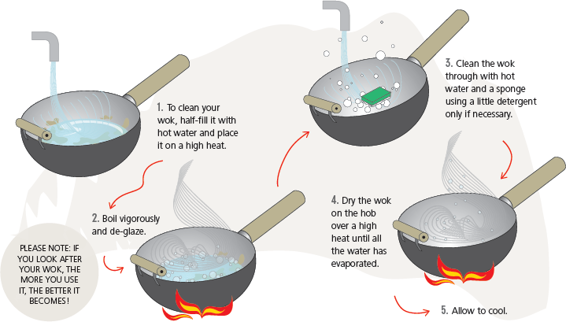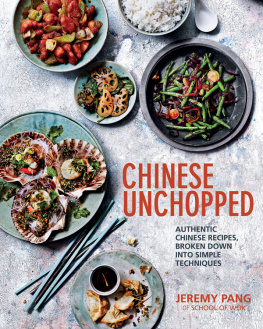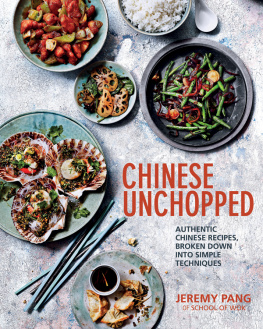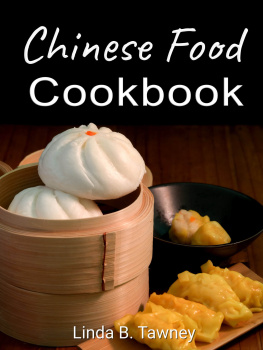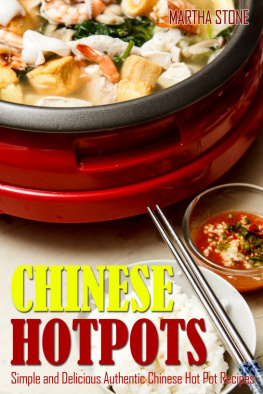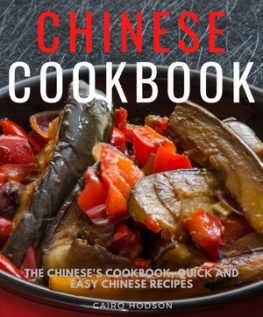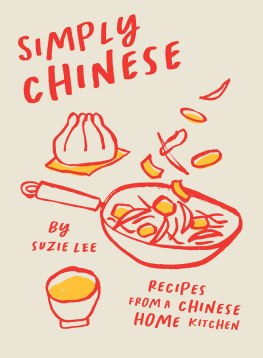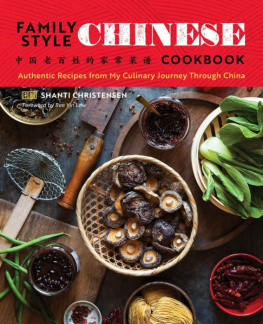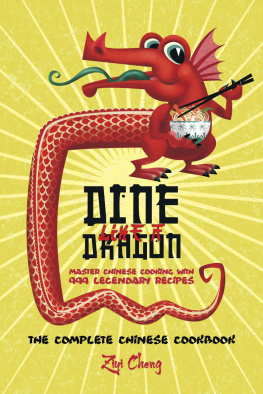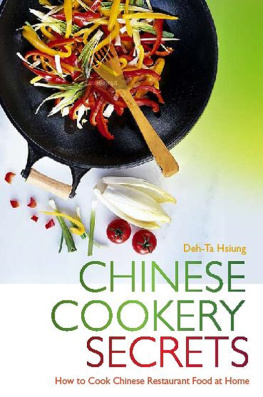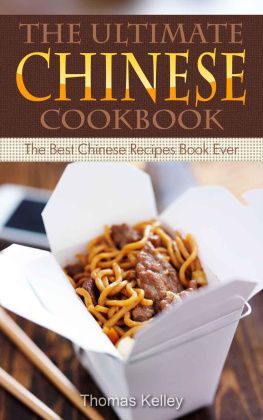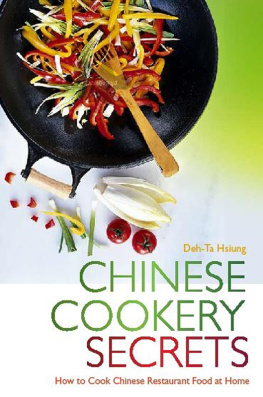ACKNOWLEDGEMENTS
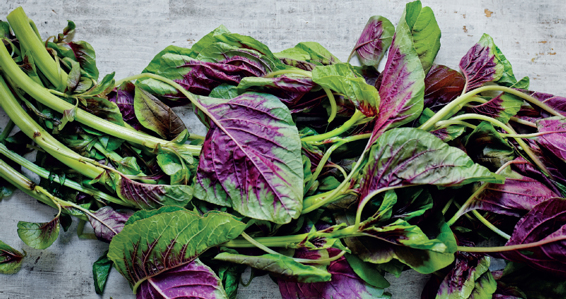
First of all, Id like to thank my wife Dee, for being my best friend and life partner and coming up with the School of Wok idea in the first place. Thanks for always humoring my crazy ideas, but mostly for sticking by me and helping me to nurture the best ones.
My dear Mum, our talents would never have developed without your relentless teaching, pushing, constant determination and endless love. And to your heavenly barbecue pork recipe, which now has the chance to sit on more coffee tables than you could ever imagine.
To my dad, for inspiring me to cook and teaching me that there is more to breakfast, lunch and dinner than just eating and that the snacks in between those meals are just as important, if not a million times more fun. And to my sisters Wendy and Jennifer, for sharing every morsel of those snacks with me since we were kids.
Nev Leaning, my business partner, for believing in me from the start, opposing me when I need to hear it, making massive decisions in business together and generally being my honorary Chinese chuckle brother.
Team School of Wok (Stefan Lind, Melissa Wong, Hannah Dryden-Jones, Ali Price, Yolanda Irais Ocon and Johnathon Campbell) for their consistent passion not just for food but also for our ever-growing success at School of Wok. You guys wok my world!
A huge thanks to Adrienne Katz Kennedy for also being a crucial member of our team, but more importantly for playing a massive part in editing all my wok waffle before the book even reached the publisher. Thanks to her persistence, beady-eyed work on the manuscript and her ability to both encourage and criticise simultaneously a unique skill to have.
To Freya Jones from The Brand New Studio for working so closely with School of Wok and I from the start and for creating such wonderful illustrations for the book.
To Borra Garson and Jan Croxon for introducing me to Quadrille and to Luisa Welch for helping to push me forward. And to everyone at Quadrille who has made this journey so enjoyable: Jane OShea, Simon Davis, Nikki Ellis, Ed Griffiths, Helen Lewis, Martin Poole, Faith Mason, Iris Bromet, Camilla Baynham, Emily Jonzen and Wilson Chung. Wow! What a team. Lets hope for more to come!
CHINESE KITCHEN ESSENTIALS

EQUIPMENT: THE CLEAVER
WHAT IS THE DIFFERENCE BETWEEN A CHINESE CLEAVER AND A CHINESE CHOPPER?
ARE THEY THE SAME THING?
ARE THEY JUST BIG WESTERN
BUTCHERS KNIVES WITH
CHINESE WRITING ON THEM?
DO I REALLY NEED ONE TO COOK CHINESE FOOD?
Well, none of these statements are necessarily correct. Much like Western and Japanese chefs knives, there are hundreds of different types of cleavers (a composite term for all of the above) that all have different uses within the Chinese cooking world. And while, no, you dont necessarily need one to make Chinese food, they are an interesting and efficient piece of equipment to have and enjoy should you decide to make the purchase. They come with their own history and their own specific technique, different from the Western knife, making them a unique and useful addition to your kitchen equipment.
Cleavers come in many different shapes, sizes, thickness and weights from general slicers to duck slicers, and general choppers to kau gong (heavyweight choppers). There are even cleavers made specially to create perfectly round dim sum pastries. The difference between a cleaver and a chopper is the weight of the knife itself and the materials its designed to cut through.
For those looking to make their first cleaver purchase I would recommend starting with a general slicer. General slicers tend to have a nice thin blade, with a well-balanced weight and a fairly sized grip or handle. These types of cleavers are designed for slicing and simple vegetable chopping, not for chopping through bones. If you want to chop through bones, its best to leave that to the butcher, or invest in a chopper: a cleaver specifically made with enough weight on the top of the blade to withstand the extra force required to cut through tougher materials.
When it comes to using your cleaver, efficiency is key. Slicing is by far the most efficient way of prepping your food. A good slicer has an incredibly sharp, thin blade with a slightly thicker top edge to allow you to use your non-knife hand to push down on it. When we slice a vegetable or a piece of meat, we tend to use a good 70% of the blade; therefore, the whole blade has been sharpened in order for it to be used efficiently. This differs from chopping, where one point of the blade is used. See for a detailed guide on how to slice vegetables and meats.
EQUIPMENT: THE WOK

Back in the old days woks used to be made of cast iron, and even the thinner woks would be extremely heavy to handle. These days, the best stir-frying woks are made of thin carbon steel. They conduct heat incredibly well, but more importantly, due to the thin metal, they also lose heat very quickly, which suits stir-frying perfectly (see for more details and advice on how to supercharge your wok cooking skills).
Traditional woks are round-bottomed, and for good reason the circular bowl assists with circulation of heat through the pan, which is essential for stir-frying or tossing ingredients through the wok. Unfortunately it is difficult to use traditional round-bottom woks on a modern hob, which is where I would definitely recommend opting for a flat-bottom wok instead. While there are plenty of flat-bottom woks on the market, my best tip is to look for a flat-bottom wok that still has curvature and maintains a smooth bowl shape even though it has a flat base. If your flat-bottom wok has a shape much like an upside-down roof, then Id recommend investing in a new one.
Non-stick woks were invented for ease of cleaning and have the benefit of simple maintenance. Although they may not be as hard-wearing as traditional carbon-steel woks, with new technology they are becoming more resistant to damage from everyday use and utensils. Personally, I still much prefer to use the traditional carbon-steel woks as they give off that extra smoky, caramelised stir-fry flavour when cooking. If its easy maintenance youre after a non-stick wok will serve you well, however if you really want to get your stir-fries closer to your favourite Chinese restaurants and takeaways (if not better), then get yourself a carbon-steel wok and take the time when youve first bought your wok to season your new toy as explained below.
SEASONING THE WOK
Most carbon-steel woks will come with an anti-rust layer on the wok to prevent it from corroding when sitting on a shop shelf, but seasoning the wok is essential to creating a natural non-stick layer on the wok. Follow the steps overleaf and look after your wok and it should last a lifetime.
CREATING A NATURAL NON-STICK LAYER:
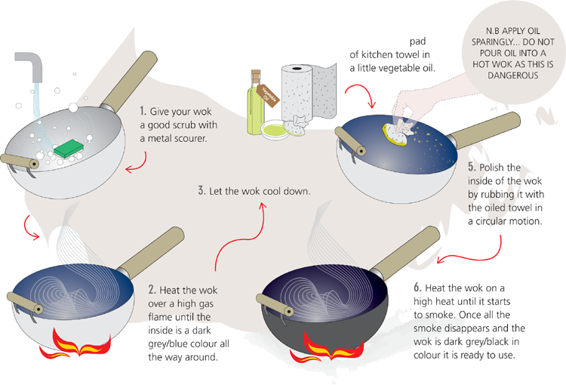
KEEPING YOUR WOK CLEAN AND SEASONED
